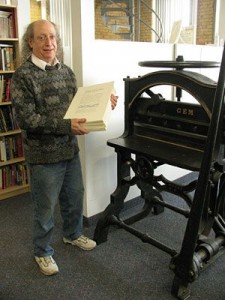
Last night, a St. Louis County grand jury decided not to bring charges against Darren Wilson, the police officer who shot Michael Brown. The demonstrations against the decision are righteous and angry and ongoing. Here’s Raven Rakia on what gets called a protest and what gets called a riot. The key difference? Who is protesting and where, not what they’re doing. “Violence is a realistic factor, and sometimes, a tactic, in all of these protests. Resisting is never peaceful. If the State fears you, it will crack down on you violently.”
Color of Change, an online civil rights organization started in the wake of Hurricane Katrina, has released a memo to reporters covering the protests in Ferguson.
For years, David Harvey has been teaching a course on Marx’s Capital at CUNY. Harvey’s well-loved and eminently helpful lectures on Volume 1 have been available for a while; now Volume 2 and part of Volume 3 is available as well.
Allan Kornblum, the founder of the excellent Coffee House Press, has died of leukemia. He was 65. Kornblum launched Coffee House in 1984, after moving to Minneapolis with his wife, Cinda. Kornblum’s colleague Chris Fischbach remembers him as wise and tireless. The press has published Ben Lerner, Ron Padgett, and Karen Tei Yamashita, among many others—in thirty years, it has put out more than four hundred books.
In the Times, David Carr admonishes journalists who knew of Cosby’s reputation as a serial abuser but said nothing. That list includes Cosby’s biographer, Mark Whitaker, as well as writers like Ta-Nehisi Coates, Kelefa T. Sanneh, and Carr himself: “We all have our excuses, but in ignoring these claims, we let down the women who were brave enough to speak out publicly against a powerful entertainer.”
The University of Texas Harry Ransom Center has acquired the archive of Gabriel García Márquez. The collection has more than two thousand letters, but very few are personal, and most are from other writers—Márquez rarely made copies of the letters he sent, and kept in touch with his family mainly over the phone. A possibly apocryphal story has it that when he got engaged to his wife he offered to buy back the love letters he’d written to her. There is little relating to his political life either, or his friendship with Castro: Again—unusually for a writer?—he was a “phone person,” his son has said. The Ransom Center also holds the archives of Joyce, Hemingway, Faulkner, and Borges.
How does the Strand stay in business? It only buys books it thinks it can sell. It sells more new books than used. It buys review copies from editorial assistants at a fraction of the wholesale price and sells them as new (which they essentially are). It has a below-market lease (which the business rents from the owners of the store, Fred Bass and his daughter Nancy). It subleases out the offices above the store. The main thing, says Vulture, is that it’s owned and run by a family who care about it.